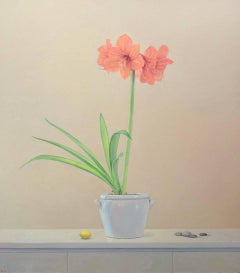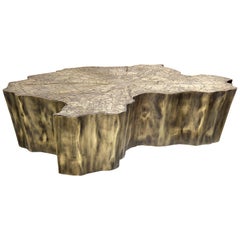Eden Patina Center Table
21st Century and Contemporary American Realist Still-life Paintings
Canvas, Oil
Recent Sales
21st Century and Contemporary Portuguese Modern Center Tables
Brass
21st Century and Contemporary Portuguese Modern Center Tables
Brass
21st Century and Contemporary Portuguese Modern Center Tables
Aluminum, Gold, Copper, Gold Plate, Brass
21st Century and Contemporary Portuguese Modern Center Tables
Brass
Boca Do Lobo for sale on 1stDibs
A passion for breaking boundaries and challenging the status quo is what sets Portuguese furniture brand Boca do Lobo apart from its contemporaries. Founded in 2005, the company’s artisans draw on traditional craftsmanship as well as contemporary furniture-making techniques to produce edgy, eye-catching dining tables, case pieces, sofas and more.
Boca do Lobo launched with a bang. The manufacturer’s first collection, Soho, is irreverent and playful, featuring multicolored sideboards as well as consoles and low-profile coffee tables made with a range of materials such as rosewood, brass, fabric and more. Each piece boasts a variety of ornamental flourishes. The Soho sideboard, for example, remains one of the series’ most popular and iconic pieces and features decorative brass drawer pulls, drawer fronts finished with gold leaf or black glass with etched detailing and other stylish touches.
The Pixel collection, which is named for the multitude of picture elements that comprise a digital image, is also hard to ignore, with striking cabinets made of more than 1,000 textured wooden triangles in varying woods and finishes such as African walnut veneer, gold leaf and black lacquer mounted on an elegant polished brass base. As part of the Pixel collection, Boca do Lobo collaborated with renowned porcelain manufacturer Vista Alegre to create a delicate, limited-edition hand-painted cabinet named “Once Upon a Time.”
With one foot in past movements such as mid-century modernism and the other firmly in the present, Boca do Lobo combines sleek, streamlined forms with Baroque-inspired ornament and exuberant colors and materials. This flair for the unexpected makes their furnishings popular in high-end residential projects as well as luxury hospitality and retail spaces like Harrods in London, the Fairmont Hotel chain in the United States and elsewhere. Boca do Lobo’s contemporary classics are putting Portuguese craftsmanship on the global stage.
Find a collection of Boca do Lobo furniture on 1stDibs.
A Close Look at modern Furniture
The late 19th and early 20th centuries saw sweeping social change and major scientific advances — both of which contributed to a new aesthetic: modernism. Rejecting the rigidity of Victorian artistic conventions, modernists sought a new means of expression. References to the natural world and ornate classical embellishments gave way to the sleek simplicity of the Machine Age. Architect Philip Johnson characterized the hallmarks of modernism as “machine-like simplicity, smoothness or surface [and] avoidance of ornament.”
Early practitioners of modernist design include the De Stijl (“The Style”) group, founded in the Netherlands in 1917, and the Bauhaus School, founded two years later in Germany.
Followers of both groups produced sleek, spare designs — many of which became icons of daily life in the 20th century. The modernists rejected both natural and historical references and relied primarily on industrial materials such as metal, glass, plywood, and, later, plastics. While Bauhaus principals Marcel Breuer and Ludwig Mies van der Rohe created furniture from mass-produced, chrome-plated steel, American visionaries like Charles and Ray Eames worked in materials as novel as molded plywood and fiberglass. Today, Breuer’s Wassily chair, Mies van der Rohe’s Barcelona chair — crafted with his romantic partner, designer Lilly Reich — and the Eames lounge chair are emblems of progressive design and vintage originals are prized cornerstones of collections.
It’s difficult to overstate the influence that modernism continues to wield over designers and architects — and equally difficult to overstate how revolutionary it was when it first appeared a century ago. But because modernist furniture designs are so simple, they can blend in seamlessly with just about any type of décor. Don’t overlook them.
Materials: brass Furniture
Whether burnished or lacquered, antique, new and vintage brass furniture can elevate a room.
From traditional spaces that use brass as an accent — by way of brass dining chairs or brass pendant lights — to contemporary rooms that embrace bold brass decor, there are many ways to incorporate the golden-hued metal.
“I find mixed metals to be a very updated approach, as opposed to the old days, when it was all shiny brass of dulled-out silver tones,” says interior designer Drew McGukin. “I especially love working with brass and blackened steel for added warmth and tonality. To me, aged brass is complementary across many design styles and can trend contemporary or traditional when pushed either way.”
He proves his point in a San Francisco entryway, where a Lindsey Adelman light fixture hangs above a limited-edition table and stools by Kelly Wearstler — also an enthusiast of juxtapositions — all providing bronze accents. The walls were hand-painted by artist Caroline Lizarraga and the ombré stair runner is by DMc.
West Coast designer Catherine Kwong chose a sleek brass and lacquered-parchment credenza by Scala Luxury to fit this San Francisco apartment. “The design of this sideboard is reminiscent of work by French modernist Jean Prouvé. The brass font imbues the space with warmth and the round ‘portholes’ provide an arresting geometric element.”
Find antique, new and vintage brass tables, case pieces and other furnishings now on 1stDibs.
Finding the Right center-tables for You
An alluring sitting area doesn’t have to be in the exact center of the room, but an antique or vintage center table is a great tool to partition off such an area.
By definition, a center table is a piece of furniture that is placed in the center of a room. Initially these appeared in the foyer or entryway before making their way into the living room. While one might keep seating furniture such as sofas against the walls to avoid limiting movement and closing off space, a center table in the living room can fill this central space without restricting the flow of the room.
One of the purposes of a center table is to anchor the rest of the furniture. It draws the eye to a specific area and invites guests to sit down. When thinking about how you’ll arrange your furniture, a good rule of thumb is to set tables an arm’s length away from seating. For instance, place a coffee table about 18 inches from a sofa so that it is within reach but not too close. In more modern layouts, tables are sometimes placed to the side to leave a large open area for foot traffic.
Because of its central position, a center table is one of the first things people will notice when entering a room. It’s important to consider how a center table can add to a room, as it’s a crucial element for defining the feel and theme of a room. Some center tables are mainly for decor, while others can be a great place to sit around over cocktails and hors d’oeuvres. Center tables are perfect for displaying decorative objects, floral arrangements, books or a cluster of prized antique vases given the prominent position of your table and the attention it will get.
The clean lines and organic forms that we typically associate with mid-century modern center tables means that they will bring a dose of sophistication to a space, and examples from the era can be found in square and round shapes. Wood tables were popular with furniture makers of the period, but versions in glass and marble are also widely available. Because Art Deco designers frequently incorporated ornamental embellishments such as exotic animal hides and veneers in their seating, case pieces and other furniture, your Art Deco center table will likely make a strong statement in any room. Alternatively, if you’re searching for something small and unassuming, Regency tables could be an option for your space.
Find a growing collection of antique and vintage center tables on 1stDibs today.


